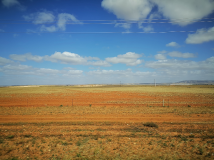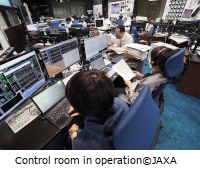★The preliminary collection team has arrived at Woomera ★
 After two weeks of quarantine in Adelaide, the preliminary team (14 people) arrived safely in Woomera. The maximum temperature today is below 30 degrees celsius, and feels refreshing as the air is dry. But the maximum temperature in the middle of the week is due to be 36 degrees celsius (!). Well, we will start preparations from tomorrow.
After two weeks of quarantine in Adelaide, the preliminary team (14 people) arrived safely in Woomera. The maximum temperature today is below 30 degrees celsius, and feels refreshing as the air is dry. But the maximum temperature in the middle of the week is due to be 36 degrees celsius (!). Well, we will start preparations from tomorrow.
(S.N.)
★SV miscellaneous thoughts ★
I was the SV (supervisor) in charge during the second half of the week. There was the big operation, TCM-2, and antenna (LGA-C) test. When there is a big operation that is different from usual, many system and attitude super engineers, including the PM (Project Manager) and FD (Flight Director) participate. As part of the science team, I was more like a bystander for this operation, as I am less familiar with the engineering side. By the way, the SV seat conforms to COVID-19 safety regulations and is in a position where you can see the whole team. These operations are based on the final procedure manual that we have to hand, having brushed-up on and checked the details many times. We proceeded quietly, but it is still quite tense. In the TCM-2 operation (11/12), the atmosphere in the control room was more relaxed than in TCM-1 and the result was cleared without difficulty. The antenna test was conducted on Friday (11/13) and there were also no problems. The operation on Saturday (11/14) was a lonely operation of three people, with only the SV, commander and a student on duty as no other people overlapped on the holiday.(M.H.)
★Precision guided navigation for Earth re-entry★
With less than a month until Earth re-entry, the precise orbit determination of Hayabusa2 —an essential task for accurate guiding of the capsule from Hayabusa2 to Woomera— is making us busier every day. The software for the orbit determination used in the Hayabusa2 final guidance phase is developed independently by three parties; the JAXA orbit determination team, the Fujitsu team that supports daily satellite operations and the NASA/JPL Shadow navigation team. By comparing the solutions obtained using three different software packages we have a system to minimise risk. If there is a slight difference between the solutions, we have a thorough discussion to locate the cause and, after fully confirming the soundness of the solution, we move onto the work for the orbit control plan. The tense days continue as we rapidly approach the finale.(H.T.)
★Observation program: Last rewrite before returning to Earth ★
A command sequence known as an observation program is used to reliably execute various operations with the onboard equipment (including the aviation cameras) installed onboard Hayabusa2 with a small number of commands. The observation program is registered by the onboard equipment —the digital electronics (DE)— but because the number of sequences that can be registered is limited, this needs to be rewritten from time to time. This time, we performed the 18th rewrite since launch and the last before the return to Earth. This observation program will be used to image the Earth moving away after the Earth return.(T.O.)
★ The main recovery team has also arrived in Adelaide ★
The main part of the capsule collection team (59 people) has now also arrived in Adelaide on November 9. All PCR tests were negative, so the first barrier is cleared. During the two week quarantine period after entering Australia, we cannot leave the hotel room at all and the three meals are all catered to each room. This is quite difficult. So that we can start work as soon as the quarantine period is over, we are making preparations via online meetings.(S.N.)
★Participation in the GREAT test ★
Hayabusa2 is preparing for re-entry, but it is also contributing to the launch of JAXA’s new GRound station for deep space Exploration And Telecommunication (GREAT) (https://www.isas.jaxa.jp/home/great ). On November 6, the motion of the antenna was tested by moving from the zenith position to the position needed to track Hayabusa2. We were surprised at how the drive speed was significantly increased compared to the conventional antenna. We anticipate great performance from the new ground station.(T.I.)
★We rehearsed the re-entry operation ★
Today, we rehearsed the re-entry operation in the control room from 14:00 to 22:00 JST. This training was to confirm with all control members that the capsule separation and Earth departure manoeuvre (TCM-5) can be performed in a timely manner using the actual Hayabusa2 spacecraft in space. Safety officers from the Australian Government also participated, and kept in contact with Japan while promptly issuing permission to execute the capsule separation and orbit control to the two Hayabusa2 teams. During rehearsal, the capsule team twice declared an “abnormality”. This generated tension in the control room but was an act by the capsule team for troubleshooting training. The control members were able to deal with the issues while rearranging the schedule and finally (according to the scenario in play), the capsule could be separated with an hour delay. As the training uses the actual spacecraft, the tension is just like in the real situation. However, as expected, the capsule separation was not done today. We enjoyed saying “capsule separation confirmed!” And “we did it!” In the simulation, but we were all terrible actors. In the real event, you will see the true joy that comes from the heart.(Y.T.)
★ The first recovery team has arrived in Adelaide ★
Finally, action has begun for the recovery team. On November 1, the first 14 members of the capsule collection team crossed the equator to arrive in Adelaide. All members are well. As a measure against the coronavirus, we will move to the Woomera Desert after two weeks of on-site quarantine. We would like to thank all the Australian officials who assisted us for entering the country.(S.N.)
★ Finally heading to Australia ★
The first team for the capsule collection is finally leaving for the collection operation on the night of November 1st. Today, the people of Sagamihara City Hall kindly held a send-off party for Hayabusa2 team and offered their encouragement. It has been 6 years since the launch and 10 years since development began and it is emotional to finally be here. In Australia in the Southern Hemisphere, we will be working under the scorching midsummer sun. In addition, we are contending with issues surrounding the coronavirus, but we want to safely collect the capsule and return it to Japan to show to everyone. We hope you are looking forward to it.(S.N.)
★ Operations are proceeding smoothly ★
We can feel that Hayabusa2 is heading towards the Earth. Firstly, communication with the spacecraft now takes less than 100 seconds for a round-trip. During the asteroid proximity phase, it took about 40 minutes. So we feel very close now. Next is the bit rate. Even when Hayabusa2 uses its highest 32 kbps rate for communication, there is still bandwidth available. And the four letters “CPSL” finally appeared in the operation procedures manual this week. Needless to say, this is the re-entry capsule. Many operators feel nervous just looking at the command with these letters. This is such a thrilling operation.(Y.Y.)
★ Operations are also fighting the weather ★
To communicate with Hayabusa2, we use a parabolic antenna with a diameter of 64m at the Usuda Deep Space Center (UDSC) in Saku City, Nagano Prefecture (which was also featured on the album jacket of a famous J-POP band this spring!). The antenna was operating smoothly today, but the wind around Usuda became quite strong during the second half of the operation phase and conditions became rough. When the wind speed exceeds 20 m/s, operations must be temporarily suspended. We therefore watched the weather information and ensured operations would be OK if there was an interruption at any time. However, the wind speed managed to stay below 20 m/s. Strong winds, snow, thunderstorms, typhoons… operations are also a battle against the weather.(N.O.)
★ Quiet operation is back ★
TCM-1 was completed successfully and quiet operations have returned. The wait time when we send a command to the spacecraft from the ground and get a return reply is getting shorter by the day and today, it was less than 2 minutes. We feel Hayabusa2 getting closer and closer to the Earth. The speed at which data is sent from the spacecraft (the downlink bit rate) has also reached the maximum value of 32 kbps, allowing luxurious operation where you can tell the status of the spacecraft quickly. To precisely determine the orbit of Hayabusa2 in preparation for re-entry, we also conducted ranging over a long period today.(N.O.)
★ TCM-1 was compelled successfully ★
 The first critical operation for the final guidance phase, TCM-1, was performed today. The attitude of the spacecraft was rotated by about 130 degrees in the direction of ΔV (acceleration), and the thruster injection occurred at around 18:00 JST. After confirming the resulting acceleration, a correction injection (trim ΔV) was made at around 19:00 and this completed the planned orbit correction. The total acceleration was about 15 cm/s. In the control room, more than a dozen people wore mask and sat spaced apart to work. Today’s operation put the spacecraft into an orbit that approaches the Earth to about 330 km. We have taken another step toward re-entry.
The first critical operation for the final guidance phase, TCM-1, was performed today. The attitude of the spacecraft was rotated by about 130 degrees in the direction of ΔV (acceleration), and the thruster injection occurred at around 18:00 JST. After confirming the resulting acceleration, a correction injection (trim ΔV) was made at around 19:00 and this completed the planned orbit correction. The total acceleration was about 15 cm/s. In the control room, more than a dozen people wore mask and sat spaced apart to work. Today’s operation put the spacecraft into an orbit that approaches the Earth to about 330 km. We have taken another step toward re-entry.
(M.Y.)
★TCM-1 tomorrow★
We are currently preparing for the TCM-1 operation, which is scheduled for 18:00 JST tomorrow. TCM stands for ‘Trajectory Correction Maneuver’. From now until just prior to re-entry, the orbit of the spacecraft will be precisely controlled in order to return the re-entry capsule to Woomera. Since yesterday, JPL has been involved in the TCM plans, and orbit determination and the orbit plan are progressing rapidly.(M.Y.)
* As we have done before, we will make these brief announcements of the on-site situation from today.
Click here for previous operation reports: http://www.hayabusa2.jaxa.jp/en/news/status/

